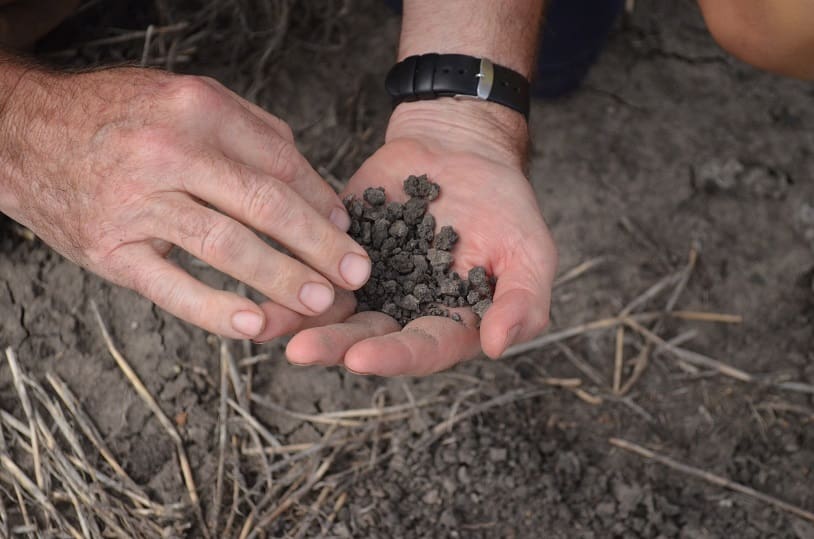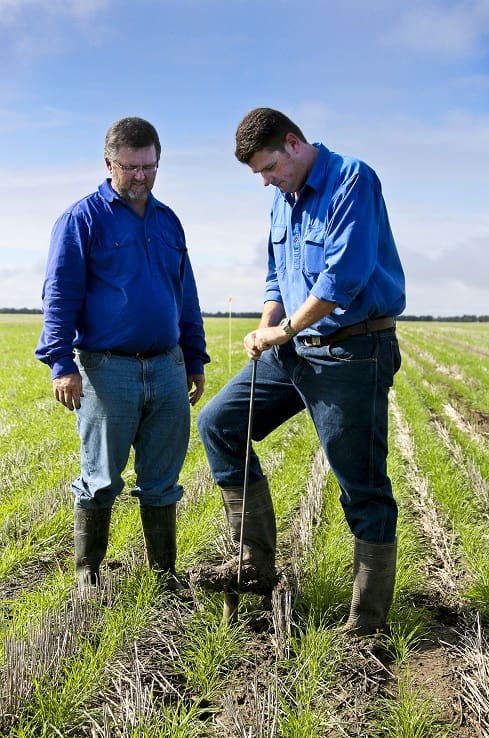
Prior to planting it is critical growers assess nitrogen levels and where it is sitting in the soil profile, especially if little or no rain has fallen to move it. (Photo: GRDC)
THIS year’s desperately dry winter across the northern farming zone may have a small upside for some grain growers in New South Wales and Queensland with the potential for summer crop fertiliser budgets to be revised on failed cropping country.
Growers fortunate enough to receive spring or summer crop planting opportunities are being encouraged to soil test to determine reserves of key nutrients like nitrogen (N), phosphorus (P), potassium (K) and sulphur (S), particularly where crops were not taken through to harvest.
Residual reserves of applied nutrients following a failed crop will depend on whether the crop was cut for hay, grazed or sprayed out and the propensity for volatilisation and mineralisation to have occurred.
Key considerations when developing a fertiliser program for the upcoming summer season include:
- Determine a yield budget for the summer crop to be grown and calculate the inputs required to reach that yield
- Soil test to determine starting nutrient reserves (after an extended dry period there may be residual from fertiliser applications made during the fallow or for a failed crop)
- Calculate removal rates from the previous crop. Cutting for hay and grazing can have a significant impact on nutrient removal
- N volatilisation can occur in grazing situations
- N mineralisation slows considerably when soils are dry and cool
- Arbuscular mycorrhizal fungi (AMF – previously known as vesicular arbuscular mycorrhizal or VAM fungi) could be low on long fallow country which could affect a crop’s ability to access nutrients such as P and zinc (Zn). AMF levels can be assessed using PREDICTA® B testing.
Rules of thumb
Nitrogen: There are some general rules of thumb with regards to N which can be used as an initial guide when starting the process of fertiliser budgeting.
In paddocks that were sown but failed to produce a crop, soil N is likely to be higher than usual because:
- Most N incorporated before sowing the failed crop will still be available if the crop was not grazed or cut for hay.
- Mineralisation of N (conversion to plant available forms) continues slowly during drought and increases strongly once it rains.
Deep soil sampling is the most reliable method for determining soil-nitrate levels as heavy rain pre-plant or early in-crop can move N down the soil profile, making it unavailable to early stage crops. In these instances, starter N may be required.
Phosphorus: Soil phosphate levels may increase a little during droughts where input rates exceed removal by crops. It’s important for growers to keep in mind that reduction of P fertiliser rates may be reasonable in the recovery year, but zero P inputs carry a risk of reduced seedling vigour.
The absence of reliable rules of thumb for summer crop P applications and the nature of summer cropping systems (wider rows, planting depth and lack of soil mixing), makes soil testing critical to establish baseline P levels, especially if it has been several years between tests.
Nutrient deficit from hay
Don’t underestimate nutrient load removed with hay. In ballpark figures, cutting hay can remove two to three times more N, and up to 10 times more K than if the crop was left for grain, and possibly five times more sulphur in both canola and cereals.
This table outlines results from work by the International Plant Nutrition Institute’s Dr Rob Norton in wheat and canola in the Wimmera and Mallee between 1990 and 2003.
No substitute for soil testing
Incitec Pivot Fertilisers agronomist Bede O’Mara recommended undertaking segmented soil tests at 0-10 centimetres, 10-30cm, 30-60cm and/or 60-90cm prior to summer planting to understand nutrient availability and any sub-soil constraints at depth, particularly following a forced long fallow or a failed crop.

Western Queensland grain grower Paul McNulty and Incitec Pivot Fertilisers agronomist Bede O’Mara doing a soil test to help determine fertiliser requirements. (Photo GRDC)
“Prior to planting, it’s very important for growers to assess N levels, know where it is sitting in the soil profile and understand the fate and form of previous applications. This is especially the case if large amounts of N were applied during the fallow and little or no rain has fallen to move it down the profile,” Mr O’Mara said.
“The position and form of N in the soil profile can have significant implications for seed safety. It’s advisable to keep seed placement 5-10cm away from the N bands; there needs to be enough time for the nitrification processes to progress.”
He said the nitrification process can produce excess ammonia gas which, if present at the wrong time, may severely reduce or damage germinating crops and young seedlings.
Nitrification relies on soil microbes and the timespan required is dependent on soil moisture, soil temperature and the quantity of N applied.
Soil testing can also help establish baseline levels of K and if results are borderline, Mr O’Mara suggested growers consider establishing K test strips.
“While corn, sorghum, cotton are not big removers of K, their maximum daily demand can be large. Any constraint or uptake disruption can have detrimental effects,” he said.
“It’s also important to remember that legumes like mungbean remove around 13 kilograms K/tonne of grain which may affect fertiliser budgets, and to keep an eye on all nutrient removals from grain and hay summer crops.”
Sulphur is another macronutrient for growers to be mindful of in the fertiliser budgeting process – due to its high mobility, deep soil sampling is recommended to gain an accurate insight into requirements.
What other impacts can dry weather have?
According to Mr O’Mara, other subsoil constraints which can be exacerbated by a dry season include chlorides and salinity. These constraints affect plant nutrient uptake and balance and are revealed by using segmented soil profile sampling methods.
At the same time, he said paddocks being returned from long fallow or that have undergone cultivation, may be low in Arbuscular mycorrhizal fungi (AMF) which could affect a crop’s ability to access nutrients such as P and zinc (Zn).
AMF populations can suffer from a lack of host plant roots during long clean fallow periods or drought, with severe reductions showing up as a syndrome known as long fallow disorder – the failure of crops to thrive despite adequate moisture.
When AMF levels have dropped, it is difficult for crops to access nutrients such as P and Zn which can cause yield losses of up to 80 per cent in chickpea, maize, mungbean and linseed, up to 60 per cent losses in sorghum and soybean and about 30 per cent in wheat and barley. For more information click here https://bit.ly/2CPqJu2.
This may require growers to apply high rates of P and Zn fertilisers if growing a crop that’s highly dependent on AMF.
New PREDICTA B tests have been developed to determine levels of the two main AMF groups, plus provisional disease risk categories within paddocks which can be useful for identifying at-risk paddocks.
Source: GRDC
For specific advice on undertaking soil tests, interpreting soil test results and fertiliser requirements, growers should contact their local advisor.
Questions can also be directed to the GRDC’s new online community website, www.communities.grdc.com.au where the `Ask an expert’ initiative gives growers and advisors rapid access to technical advice and information on important seasonal issues.
More information
Incitec Pivot Fertilisers agronomist Bede O’Mara, 0417 896377 [email protected]
Contact: Richard Holzknecht, GRDC
0408 773 865
[email protected]
Useful resources
https://communities.grdc.com.au/crop-nutrition/happens-year-hayed-off-crop/
Nutrients removed in hay crops – http://anz.ipni.net/article/ANZ-3196
Sub-soil constraints in Queensland’s grain cropping soils – http://www.regional.org.au/au/asssi/supersoil2004/s9/oral/1772_dangy.htm
The what, where and why of soil testing in the northern region – https://grdc.com.au/resources-and-publications/grdc-update-papers/tab-content/grdc-update-papers/2015/07/the-what-where-and-why-of-soil-testing-in-the-northern-region
Grain Central: Get our free daily cropping news straight to your inbox – Click here

HAVE YOUR SAY